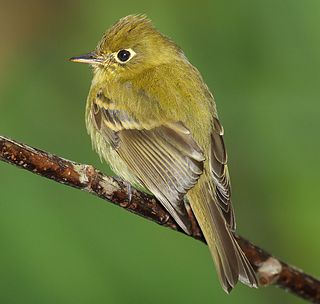
The tyrant flycatchers (Tyrannidae) are a family of passerine birds which occur throughout North and South America. They are considered the largest family of birds known, with more than 400 species. They are the most diverse avian family in every country in the Americas, except for the United States and Canada. The members vary greatly in shape, patterns, size and colors. Some tyrant flycatchers may superficially resemble the Old World flycatchers, which they are named after but are not closely related to. They are members of suborder Tyranni (suboscines), which do not have the sophisticated vocal capabilities of most other songbirds.

The Tyranni (suboscines) are a suborder of passerine birds that includes more than 1,000 species, the large majority of which are South American. It is named after the type genus Tyrannus. These have a different anatomy of the syrinx musculature than the oscines, hence the common name of suboscines.

The vermilion flycatcher is a small passerine bird in the tyrant flycatcher family found throughout South America and southern North America. It is a striking exception among the generally drab Tyrannidae due to its vermilion-red coloration. The males have bright red crowns, chests, and underparts, with brownish wings and tails. Females lack the vivid red coloration and can be hard to identify—they may be confused for the Say's phoebe. The vermilion flycatcher's song is a pit pit pit pidddrrrreeedrr, which is variable and important in establishing a territory. Riparian habitats and semi-open environments are preferred. As aerial insectivores, they catch their prey while flying. Their several months-long molt begins in summer.

The black phoebe is a passerine bird in the tyrant-flycatcher family. It breeds from southwest Oregon and California south through Central and South America. It occurs year-round throughout most of its range and migrates less than the other birds in its genus, though its northern populations are partially migratory. Six subspecies are commonly recognized, although two are occasionally combined as a separate species, the white-winged phoebe.
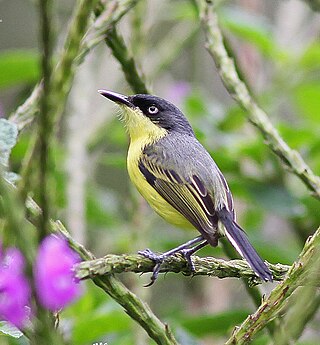
The common tody-flycatcher or black-fronted tody-flycatcher is a very small passerine bird in the tyrant flycatcher family. It breeds from southern Mexico to northwestern Peru, eastern Bolivia and southern, eastern and northeast Brazil.

The tufted tit-tyrant is a species of bird in the tyrant flycatcher family Tyrannidae. This species is found in western South America; its range stretches from southern Colombia south along the Andes mountains to Tierra del Fuego. It prefers to live in upper montane forests and shrublands; however, it is a habitat generalist and can be found across a wide range of ecosystems. The tufted tit-tyrant has three subspecies, including the nominate subspecies Anairetes parulus parulus, A. p. aequatorialis, and A. p. patagonicus, and is very closely related to the Juan Fernández tit-tyrant. It is very small with a distinctive and conspicuous crest. The bird's head is black overall with white supraloral and postocular stripes. Its dull grayish-brown back contrasts with its white throat and breast that are covered with black streaks and pale, unmarked yellow underbelly. There are few noticeable differences in plumage between the subspecies. It is a vocal flycatcher with a broad repertoire of songs.
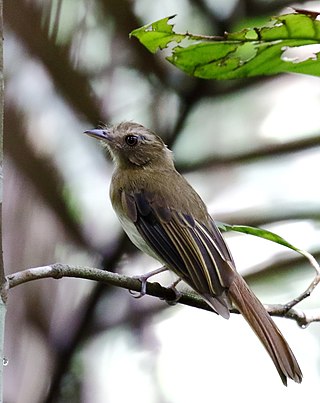
The brownish twistwing, also known as the brownish flycatcher, is a species of bird in the Tyrannidae. It was the only member of the genus Cnipodectes until the description of Cnipodectes superrufus in 2007.

The many-colored rush tyrant or many-coloured rush tyrant is a small passerine bird of South America belonging to the tyrant flycatcher family, Tyrannidae. It is the only member of the genus Tachuris and is sometimes placed in a separate monotypic family. It inhabits marshland and reedbeds around lakes and rivers. It is particularly associated with stands of Scirpus. The nest is built among plant stems.

The black-backed water tyrant is a species of bird in the family Tyrannidae, the tyrant flycatchers. It is one of three species in the genus Fluvicola.

McConnell's flycatcher is a species of bird in the tyrant flycatcher family Tyrannidae. It is found in the Guiana Shield, northern Brazil, Peru and Bolivia. Its natural habitats are subtropical or tropical moist lowland forests and subtropical or tropical moist montane forests.

The little ground tyrant is a species of bird in the family Tyrannidae, the tyrant flycatchers and is the only species placed in the genus Syrtidicola. It is found in Amazonian Brazil, Peru, and Bolivia; also smaller regions of Colombia and Ecuador. Its natural habitats are subtropical or tropical moist shrubland and rivers.

The southern mouse-colored tyrannulet is a species of bird in the tyrant flycatcher family Tyrannidae. It occurs in a wide range of scrubby and wooded habitats in tropical and subtropical South America, being absent from the southernmost part of the continent, the high Andes and dense rainforest. It is generally common, but its small size and dull plumage results in it often being overlooked – or at least not identified, as it resembles several other tyrant flycatchers.

Lulu's tody-flycatcher, also known as Johnson's tody-flycatcher, is a species of bird in the family Tyrannidae. It was briefly known as Lulu's tody-tyrant, but following the death of Ned K. Johnson, one of the people responsible for the description of this species in 2001, the name was modified to Johnson's tody-tyrant by the SACC. Following the move of this species to the genus Poecilotriccus from Todirostrum, it was recommended modifying the name to tody-flycatcher. It is endemic to humid thickets, usually near bamboo, in the highlands of Amazonas and San Martín in northern Peru. It is threatened by habitat loss and is consequently considered endangered by BirdLife International and IUCN.

The rufous-crowned tody-flycatcher is a species of bird in the family Tyrannidae, the tyrant flycatchers. It was formerly placed in the genus Todirostrum, and has been known as the rufous-crowned tody-tyrant. It is found in thickets and second growth in the Andes of Venezuela, Colombia, Ecuador and far northern Peru.
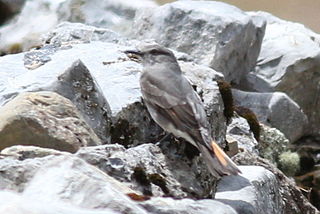
The rufous-webbed bush tyrant is a species of bird in the family Tyrannidae. It is found mostly in Argentina, Bolivia, and Peru with a few records in Chile, where its natural habitats are subtropical or tropical moist montane forests and subtropical or tropical high-altitude shrubland.

Uromyias is a genus of small Andean, tyrant flycatchers known as tit-tyrants. They were formerly recognized based on syrinxial and plumage characters, including a flatter crest and a longer tail, but was included within Anairetes due to genetic analysis. Recent analyses suggested splitting into Uromyias again.

The rufous twistwing is a species of bird in the family Tyrannidae. It was described as a new species in 2007.

Anairetes is a genus containing the tit-tyrants, a group of small, mainly Andean birds, in the tyrant flycatcher family Tyrannidae. The group briefly included the genus Uromyias, which had been recognized based on syringeal and plumage characters, including a flatter crest and a longer tail, but was included within Anairetes due to genetic analysis. Recent analyses suggested splitting into Uromyias again. Anairetes is believed to be most closely related to the genera Mecocerculus and Serpophaga; however, there is no definitive evidence supporting this claim.
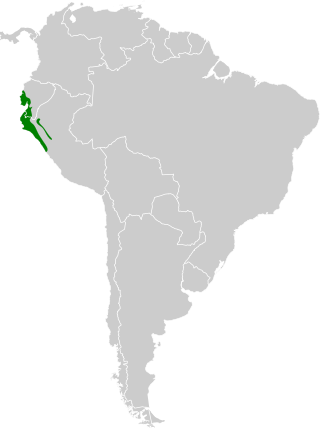
The Tumbesian tyrannulet or Tumbes tyrannulet is a species of bird in the tyrant flycatcher family Tyrannidae. It occurs in desert scrub and wooded habitats in southwest Ecuador and northwest Peru. Within its restricted range it is fairly common, but its small size and dull plumage results in it often being overlooked – or at least not identified, as it resembles several other tyrant flycatchers. The common name is from the city of Tumbes in northwest Peru.























